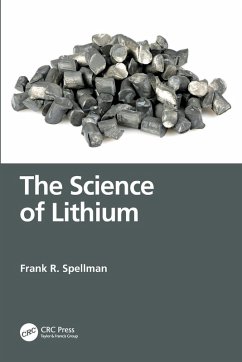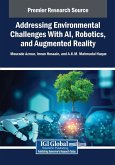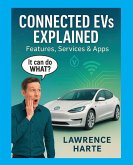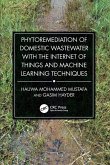Frank R. Spellman
The Science of Lithium
Frank R. Spellman
The Science of Lithium
- Broschiertes Buch
- Merkliste
- Auf die Merkliste
- Bewerten Bewerten
- Teilen
- Produkt teilen
- Produkterinnerung
- Produkterinnerung
The Science of Lithium provides a comprehensive survey of information on this highly sought-after element, including its chemistry, metallurgical properties, and industrial applications, as well as its drawbacks and environmental implications.
Andere Kunden interessierten sich auch für
![Addressing Environmental Challenges With AI, Robotics, and Augmented Reality Addressing Environmental Challenges With AI, Robotics, and Augmented Reality]() Addressing Environmental Challenges With AI, Robotics, and Augmented Reality170,99 €
Addressing Environmental Challenges With AI, Robotics, and Augmented Reality170,99 €![Seamless 3D Navigation in Indoor and Outdoor Spaces Seamless 3D Navigation in Indoor and Outdoor Spaces]() Jinjin YanSeamless 3D Navigation in Indoor and Outdoor Spaces73,99 €
Jinjin YanSeamless 3D Navigation in Indoor and Outdoor Spaces73,99 €![Handbook of Energy Transitions Handbook of Energy Transitions]() Muhammad AsifHandbook of Energy Transitions62,99 €
Muhammad AsifHandbook of Energy Transitions62,99 €![Integrating Sustainability and Autonomous Transportation for Enhanced Urban Mobility Integrating Sustainability and Autonomous Transportation for Enhanced Urban Mobility]() Integrating Sustainability and Autonomous Transportation for Enhanced Urban Mobility147,99 €
Integrating Sustainability and Autonomous Transportation for Enhanced Urban Mobility147,99 €![Connected EVs Explained Connected EVs Explained]() Harte James HarteConnected EVs Explained24,99 €
Harte James HarteConnected EVs Explained24,99 €![Handbook of Water and Wastewater Treatment Plant Operations Handbook of Water and Wastewater Treatment Plant Operations]() Frank R. SpellmanHandbook of Water and Wastewater Treatment Plant Operations132,99 €
Frank R. SpellmanHandbook of Water and Wastewater Treatment Plant Operations132,99 €![Phytoremediation of Domestic Wastewater with the Internet of Things and Machine Learning Techniques Phytoremediation of Domestic Wastewater with the Internet of Things and Machine Learning Techniques]() Hauwa Mohammed MustafaPhytoremediation of Domestic Wastewater with the Internet of Things and Machine Learning Techniques66,99 €
Hauwa Mohammed MustafaPhytoremediation of Domestic Wastewater with the Internet of Things and Machine Learning Techniques66,99 €-
-
-
The Science of Lithium provides a comprehensive survey of information on this highly sought-after element, including its chemistry, metallurgical properties, and industrial applications, as well as its drawbacks and environmental implications.
Produktdetails
- Produktdetails
- Verlag: CRC Press
- Seitenzahl: 324
- Erscheinungstermin: 27. Mai 2025
- Englisch
- Abmessung: 234mm x 156mm x 18mm
- Gewicht: 494g
- ISBN-13: 9781032482057
- ISBN-10: 1032482052
- Artikelnr.: 73870812
- Herstellerkennzeichnung
- Libri GmbH
- Europaallee 1
- 36244 Bad Hersfeld
- gpsr@libri.de
- Verlag: CRC Press
- Seitenzahl: 324
- Erscheinungstermin: 27. Mai 2025
- Englisch
- Abmessung: 234mm x 156mm x 18mm
- Gewicht: 494g
- ISBN-13: 9781032482057
- ISBN-10: 1032482052
- Artikelnr.: 73870812
- Herstellerkennzeichnung
- Libri GmbH
- Europaallee 1
- 36244 Bad Hersfeld
- gpsr@libri.de
Frank R. Spellman is a retired assistant professor of Environmental Health at Old Dominion University, Norfolk, VA and author of more than 155 books. Spellman has been cited in more than 400 publications. He serves as a professional expert witness and incident/accident investigator for the U.S. Department of Justice and a private law firm and consults on homeland security vulnerability assessments (VAs) for critical infrastructure including water/wastewater facilities nationwide. Dr. Spellman lectures on sewage treatment, water treatment, and homeland security and health and safety topics throughout the country and teaches water/wastewater operator short courses at Virginia Tech (Blacksburg, VA). He holds a BA in Public Administration; BS in Business Management; MBA, Master of Science, MS, in Environmental Engineering and PhD Environmental Engineering.
PART 1: Introduction. 1. Lithium, What Is It? 2. Manifestation. 3.
Production. PART 2: Applications. 4. Air Purification. 5. Electronic
Devices. 6. Optical Devices. 7. Glassware. 8. Metallurgy. 9. Alloy. 10.
Lubricating Grease. PART 3: Medicinal Use of Lithium. 11. Mania Treatment.
12. Medical Lithium: Adverse Effects. PART 4: Lithium Power Applications.
13. Understanding Electricity. 14. Electrical Calculations. 15. Redox. 16.
AC Theory. 17. Battery-Supplied Energy. 18. Lithium Batteries. 19.
Lithium-Ion (Rechargeable) Battery Production. 20. Lithium-Ion Battery
Operation. PART 5: Environmental & Safety Concerns. 21. Electric Vehicle
Terminology. 22. Dynamics of Vehicle Motion. 23. Electric Motors. 24. DC/DC
Converters. 25. Inverters. PART 6: Fuel Cells. 26. Fuel Cells. PART 7:
Final Word on Environmental and Safety Concerns. 27. Environmental
Concerns. 28. Safety Concerns. Epilogue.
Production. PART 2: Applications. 4. Air Purification. 5. Electronic
Devices. 6. Optical Devices. 7. Glassware. 8. Metallurgy. 9. Alloy. 10.
Lubricating Grease. PART 3: Medicinal Use of Lithium. 11. Mania Treatment.
12. Medical Lithium: Adverse Effects. PART 4: Lithium Power Applications.
13. Understanding Electricity. 14. Electrical Calculations. 15. Redox. 16.
AC Theory. 17. Battery-Supplied Energy. 18. Lithium Batteries. 19.
Lithium-Ion (Rechargeable) Battery Production. 20. Lithium-Ion Battery
Operation. PART 5: Environmental & Safety Concerns. 21. Electric Vehicle
Terminology. 22. Dynamics of Vehicle Motion. 23. Electric Motors. 24. DC/DC
Converters. 25. Inverters. PART 6: Fuel Cells. 26. Fuel Cells. PART 7:
Final Word on Environmental and Safety Concerns. 27. Environmental
Concerns. 28. Safety Concerns. Epilogue.
PART 1: Introduction. 1. Lithium, What Is It? 2. Manifestation. 3. Production. PART 2: Applications. 4. Air Purification. 5. Electronic Devices. 6. Optical Devices. 7. Glassware. 8. Metallurgy. 9. Alloy. 10. Lubricating Grease. PART 3: Medicinal Use of Lithium. 11. Mania Treatment. 12. Medical Lithium: Adverse Effects. PART 4: Lithium Power Applications. 13. Understanding Electricity. 14. Electrical Calculations. 15. Redox. 16. AC Theory. 17. Battery-Supplied Energy. 18. Lithium Batteries. 19. Lithium-Ion (Rechargeable) Battery Production. 20. Lithium-Ion Battery Operation. PART 5: Environmental & Safety Concerns. 21. Electric Vehicle Terminology. 22. Dynamics of Vehicle Motion. 23. Electric Motors. 24. DC/DC Converters. 25. Inverters. PART 6: Fuel Cells. 26. Fuel Cells. PART 7: Final Word on Environmental and Safety Concerns. 27. Environmental Concerns. 28. Safety Concerns. Epilogue.
PART 1: Introduction. 1. Lithium, What Is It? 2. Manifestation. 3.
Production. PART 2: Applications. 4. Air Purification. 5. Electronic
Devices. 6. Optical Devices. 7. Glassware. 8. Metallurgy. 9. Alloy. 10.
Lubricating Grease. PART 3: Medicinal Use of Lithium. 11. Mania Treatment.
12. Medical Lithium: Adverse Effects. PART 4: Lithium Power Applications.
13. Understanding Electricity. 14. Electrical Calculations. 15. Redox. 16.
AC Theory. 17. Battery-Supplied Energy. 18. Lithium Batteries. 19.
Lithium-Ion (Rechargeable) Battery Production. 20. Lithium-Ion Battery
Operation. PART 5: Environmental & Safety Concerns. 21. Electric Vehicle
Terminology. 22. Dynamics of Vehicle Motion. 23. Electric Motors. 24. DC/DC
Converters. 25. Inverters. PART 6: Fuel Cells. 26. Fuel Cells. PART 7:
Final Word on Environmental and Safety Concerns. 27. Environmental
Concerns. 28. Safety Concerns. Epilogue.
Production. PART 2: Applications. 4. Air Purification. 5. Electronic
Devices. 6. Optical Devices. 7. Glassware. 8. Metallurgy. 9. Alloy. 10.
Lubricating Grease. PART 3: Medicinal Use of Lithium. 11. Mania Treatment.
12. Medical Lithium: Adverse Effects. PART 4: Lithium Power Applications.
13. Understanding Electricity. 14. Electrical Calculations. 15. Redox. 16.
AC Theory. 17. Battery-Supplied Energy. 18. Lithium Batteries. 19.
Lithium-Ion (Rechargeable) Battery Production. 20. Lithium-Ion Battery
Operation. PART 5: Environmental & Safety Concerns. 21. Electric Vehicle
Terminology. 22. Dynamics of Vehicle Motion. 23. Electric Motors. 24. DC/DC
Converters. 25. Inverters. PART 6: Fuel Cells. 26. Fuel Cells. PART 7:
Final Word on Environmental and Safety Concerns. 27. Environmental
Concerns. 28. Safety Concerns. Epilogue.
PART 1: Introduction. 1. Lithium, What Is It? 2. Manifestation. 3. Production. PART 2: Applications. 4. Air Purification. 5. Electronic Devices. 6. Optical Devices. 7. Glassware. 8. Metallurgy. 9. Alloy. 10. Lubricating Grease. PART 3: Medicinal Use of Lithium. 11. Mania Treatment. 12. Medical Lithium: Adverse Effects. PART 4: Lithium Power Applications. 13. Understanding Electricity. 14. Electrical Calculations. 15. Redox. 16. AC Theory. 17. Battery-Supplied Energy. 18. Lithium Batteries. 19. Lithium-Ion (Rechargeable) Battery Production. 20. Lithium-Ion Battery Operation. PART 5: Environmental & Safety Concerns. 21. Electric Vehicle Terminology. 22. Dynamics of Vehicle Motion. 23. Electric Motors. 24. DC/DC Converters. 25. Inverters. PART 6: Fuel Cells. 26. Fuel Cells. PART 7: Final Word on Environmental and Safety Concerns. 27. Environmental Concerns. 28. Safety Concerns. Epilogue.









